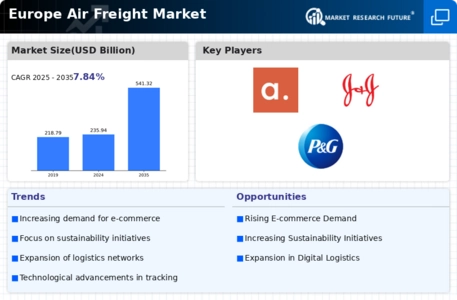E-commerce Growth
The rapid expansion of the e-commerce sector is a primary driver of the Global Europe Air Freight Market Industry. As online shopping continues to gain traction, businesses require efficient logistics solutions to meet consumer demands. In 2024, the market is projected to reach 235.94 USD Billion, with air freight playing a crucial role in ensuring timely deliveries. The convenience of air transport allows retailers to offer faster shipping options, thus enhancing customer satisfaction. This trend is expected to persist, as e-commerce sales are anticipated to grow significantly, further propelling the air freight sector.
Global Trade Dynamics
The evolving landscape of global trade significantly influences the Global Europe Air Freight Market Industry. As countries engage in trade agreements and partnerships, the demand for air freight services is likely to increase. The facilitation of trade routes and reduction of tariffs can lead to a surge in exports and imports, necessitating efficient logistics solutions. In 2024, the market is expected to benefit from these dynamics, with air freight providing a vital link for businesses looking to expand their reach. This trend is projected to continue, with the market anticipated to grow to 541.32 USD Billion by 2035.
Regulatory Frameworks
The regulatory environment surrounding air freight operations plays a crucial role in shaping the Global Europe Air Freight Market Industry. Governments are increasingly implementing policies aimed at enhancing safety, security, and environmental sustainability within the sector. Compliance with these regulations can drive operational improvements and foster innovation among air freight providers. For instance, stricter emissions regulations may encourage the adoption of more fuel-efficient aircraft, thereby reducing operational costs. As these regulations evolve, they may create both challenges and opportunities for market players, influencing their strategies and investments in the coming years.
Market Growth Projections
The Global Europe Air Freight Market Industry is projected to experience substantial growth over the coming years. With an anticipated market value of 235.94 USD Billion in 2024, the industry is expected to expand significantly, reaching 541.32 USD Billion by 2035. This growth trajectory indicates a robust compound annual growth rate of 7.84% from 2025 to 2035. Such projections highlight the increasing reliance on air freight services across various sectors, driven by factors such as globalization, technological advancements, and evolving consumer preferences. This upward trend underscores the vital role of air freight in facilitating international trade and commerce.
Technological Advancements
Innovations in technology are reshaping the Global Europe Air Freight Market Industry, enhancing operational efficiency and reliability. The adoption of advanced tracking systems, automated warehousing, and AI-driven logistics solutions is streamlining processes and reducing costs. For instance, real-time tracking enables shippers and customers to monitor shipments, improving transparency and trust. As technology continues to evolve, it is likely to facilitate faster and more efficient air freight operations, attracting more businesses to utilize air transport for their logistics needs. This technological shift may contribute to the projected market growth, with a CAGR of 7.84% from 2025 to 2035.
Consumer Preferences for Speed
The growing consumer preference for rapid delivery options is a significant driver of the Global Europe Air Freight Market Industry. As customers increasingly expect faster shipping times, businesses are compelled to adopt air freight solutions to meet these demands. This shift in consumer behavior is evident in various sectors, including retail and pharmaceuticals, where timely delivery is critical. The air freight market is poised to capitalize on this trend, as it offers the quickest transportation method available. Consequently, the demand for air freight services is likely to rise, contributing to the overall market growth and reinforcing its importance in the logistics landscape.














Leave a Comment